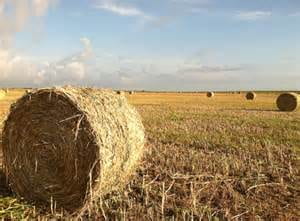by Dale Blasi, Stocker, Forages, Nutrition and Management specialist and Jaymelynn Farney, Beef Systems Specialist, Parsons
Harvesting forages for future use during the winter feeding period or during periods of drought represents a significant cost outlay for cattle operations. Previous research conducted at KSU suggests that large round bales composed of Wheat or Sudan hay can incur feed waste of up to 25% of a bale’s weight when unrolled. Much of this loss can be attributed to factors associated with delayed harvest (reduced forage quality) and/or improper storage techniques prior to feeding.
 Many producers do not recognize that with a 6-foot diameter large round bale, more than 1/3 the weight of a bale can be found in the outer 6 inches and 50% of the volume is in the outer 12 inches. Weathering losses in round bales stored outside unprotected are commonly found to occur up to 4 inches although hay type also influences the degree of loss due to weather exposure. For example, stemmy hays such as alfalfa, sudan, and mature small grains have a greater loss than grass hay. Moreover, areas that have higher rainfall also have a greater weathering loss than low rainfall areas. Unprotected hay that is stored outside has the greatest weathering loss, followed by covered hay stored outside, with the least amount of loss occurring with barn stored hay; however, there is still some storage loss found with storing hay in the barn, especially with an extended storage period.
Many producers do not recognize that with a 6-foot diameter large round bale, more than 1/3 the weight of a bale can be found in the outer 6 inches and 50% of the volume is in the outer 12 inches. Weathering losses in round bales stored outside unprotected are commonly found to occur up to 4 inches although hay type also influences the degree of loss due to weather exposure. For example, stemmy hays such as alfalfa, sudan, and mature small grains have a greater loss than grass hay. Moreover, areas that have higher rainfall also have a greater weathering loss than low rainfall areas. Unprotected hay that is stored outside has the greatest weathering loss, followed by covered hay stored outside, with the least amount of loss occurring with barn stored hay; however, there is still some storage loss found with storing hay in the barn, especially with an extended storage period.
Management practices for large round bales
- Make a dense bale. A dense bale will sag less, have less surface area in contact with the ground, shed more precipitation and protect the inner bale from weathering, and make more efficient use of the bale wrap deployed. Bale density is affected by the baler, the experience of the operator, and the type of hay. Finer stemmed hays form denser bales. As a rule of thumb, the density of round bales should be a minimum of 10 pounds of hay per cubic foot.
- Store bales end-to-end to reduce storage loss. Tightly stacking bales end to end better utilizes the storage area and protects the ends of bales from weathering. If bales are not stacked tightly against each other, rain will penetrate the ends and increase damage. Be mindful of positioning the hay bales on a well-drained site. A gently sloping site with a southern or southeastern exposure is ideal to maximize solar drying and encourage drainage away from the bales. To further reduce wastage on the bottom of the bales, some producers have elevated their bales using old tires, shipping pallets or stored on a base layer of 3 to 4 inches of crushed rock. When more than one row of bales is needed, be mindful to space adjacent rows at least 3 feet apart. This simple action will increase air flow and allow the sun to reach the back row.
- Avoid stacking large round bales. Many producers will stack their large round bales in a pyramid formation with the thought of maximizing their utilization of space. However, this strategy will usually increase dry matter losses in the stack as a result of the trapped moisture and reduced air movement.
- DO NOT cover bales. Aside from adding cost, covering bales will potentially trap moisture the same as wrapping them in plastic. If high moisture hay (over 18 percent) is sealed under plastic, quality losses may result from excessive heating and mold development.
- DO NOT store bales under trees. During harvest, many producers will move the large round bales to the field perimeter with good intentions of moving bales to a central location when it is convenient. However, locating bales under trees will encourage degradation of their bales because of trapped moisture and the inability to dry from sunlight.
Forage production for future use as a consequence of dry weather conditions or winter feeding is an important element for all cattle producers who wish to insure the nutritional needs of their cowherd are being met. Proper attention throughout the entire hay harvesting process, including proper storage will pay future dividends towards this effort.